I’ve been pike fly fishing for about 6 years and the adventure started with a fishing trip to Trawsfynydd with a friend who is a fanatic pike angler. It wasn’t long before I had my first pike on the hook. This first encounter had me…
Well & truly hooked on fly fishing for Pike.
By the end of the day, I’d caught three pike that left me wanting more.
Pike fly fishing is an exciting form of angling that allows you to catch some powerful and aggressive fish and put a great bend into your fly rod during the trout and salmon close season.
This post charts my exciting journey from novice to pike fly addict and is a beginner’s guide to pike fly fishing. It will cover the basic tackle requirements…
- Pike fly rods
- Fly reels for pike fishing
- Pike fly lines
- Pike flies
- Essential pike fly fishing tips that will help you enjoy this amazing sport.
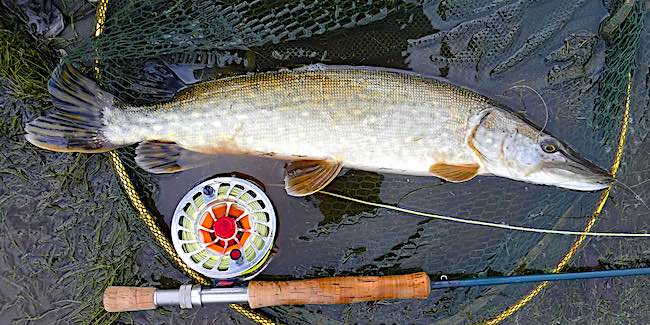
So, let’s first look at the fishing gear you’ll need to start fly fishing for Pike.
Basic Tackle Requirements for Pike Fly Fishing
Fly fishing for pike has become a popular sport and tackle manufacturers have responded to this trend by producing gear designed for the needs of pike fly anglers.
Pike fly Rod requirements.
The most critical piece of equipment for pike fly fishing is the rod. So, if you’re serious about embarking on a pike fly fishing journey, most pike anglers use a 9ft fly rod with a line rating of 9 to 11, a medium-fast action, and plenty of strength. The main reasons for that are…
- Typical pike flies are “heavily dressed” and tied to a 3/0 or 4/0 hook. These bulky flies lack aerodynamics and thus require heavy lines to cast the fly a reasonable distance.
- Have the strength to quickly subdue large pike (20+ lbs) and lower the risk of stressing the fish through the fight.
- Pike have bony mouths, so a fly rod with plenty of backbone will help you set the hook.
Many rod manufacturers offer pike fly rods to meet all budgets. Also, a selection of pike fishing kits that will include a rod, reel, backing and line is a great place if you want to have a go at pike fly fishing.
If like me, you’re an experienced fly angler coming from a reservoir trout fishing background or saltwater fly fishing you probably have a 7 or 8# fly rod that you could use to begin a pike fly fishing journey with.
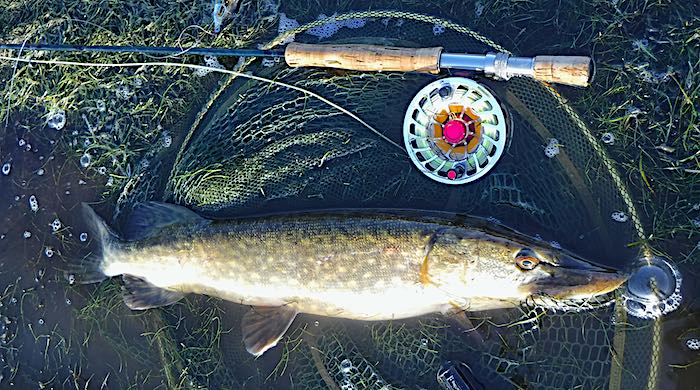
That’s how I started, using a 10ft 7# trout rod and a 9ft 8# Guideline Deep Blue saltwater fly rod, which enabled me to enjoy some great-sport catching amazing pike. Those rods, however, do limit the size of pike fly that can be cast effectively (max. 4 – 5in fly). Also, it will be a struggle to quickly subdue a pike over 20 lbs using them.
The main reason for using a 9 to 11# fly rod and line when targeting pike is that it allows you to cast large (not aerodynamic) pike flies with ease.
Pike Fly Reels
You will need a Large Arbor fly reel capable of holding a 9 to 10# line and 100 m of 40lb Nylon or braid. A reel with a strong disc drag system is useful but not essential since it helps in the landing of big pike, but they don’t often make long runs like saltwater predator fish.
I use an Airflo V2 reel with a sealed drag system because it doubles as a saltwater fly reel.
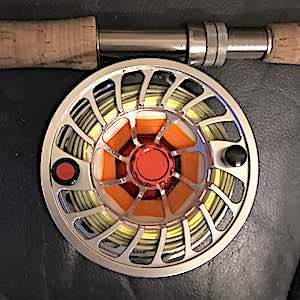
Pike fly Lines
The fly line for pike fly fishing is probably the most important thing to get right because you will need to cast large, bulky flies compared to other types of fly fishing.
Select a line with a short, aggressive taper because a standard weight forward line will not generate the line speed you need to cast big predator flies. You don’t have to buy an expensive line, but it should have been designed for casting large flies.
Choose a multicoloured line where the head (the heavier section of the WF) and the thin running line are different colours. Because this gives you a clear indicator of where the best loading point is and makes them quite foolproof when the colour change reaches the end of your rod when false casting, it’s time to let it fly.
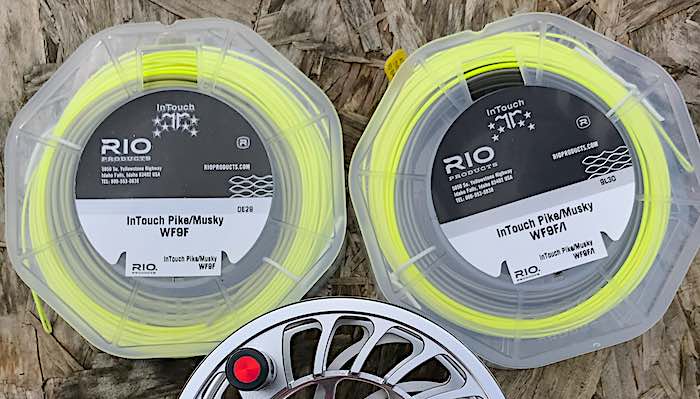
Because I do most of my pike fly fishing from the bank on Stillwaters, I primarily use floating and slow-sinking Rio InTouch Musky/pike fly lines. If you plan to fish rivers or deep reservoirs from a boat, you’ll also need a fast-sinking line.
If you’re just starting I would recommend starting with one of the reasonably priced pike fly line options (e.g. Mega High Speed fly line from Predator Fly Fishing). The Rio lines are great but I only use them because I won them in a competition and will probably go for a lower cost option when I have to replace them.
Pike Leader Set-up – Basic leader construction
Pike have a mouth full of razor-sharp teeth that cut through polymeric leaders like butter. Therefore, the end section of the leader needs to be some kind of wire trace.
You can buy a premade knotless tapered leader that has a short wire trace and clip on the end to attach your fly (e.g. Airflo Predator Polyleader).
They are ideal for the beginner but are more expensive than making a simple pike leader setup yourself, which is not that difficult.
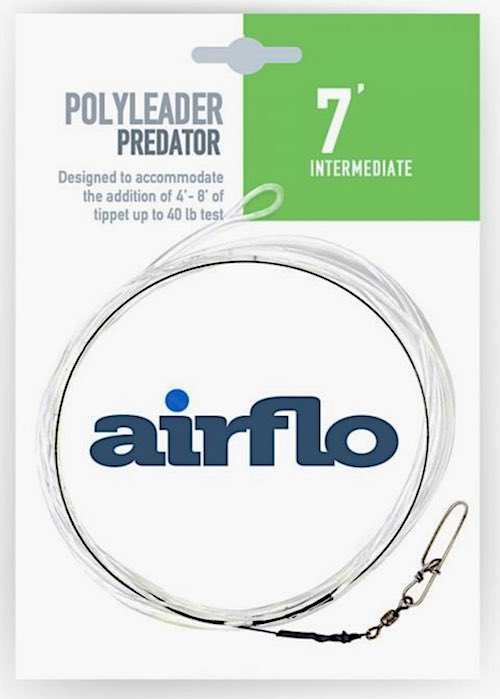
I prefer to make a simple leader set-up consisting of a 5ft length of 50 lbs mono and tie perfection loops on either end and a 2ft length of multi-strand plastic coated wire trace (20 – 35lbs breaking strain) with and tie a perfection loop on one end.
Connect one end of the mono to the fly line and the other end of the mono to the wire trace using the loop-to-loop connection. Then I attach the fly to the wire trace using a Rapala knot rather than using clips.
Wire traces
Generally, pike are not leader-shy so don’t be overly concerned with wire thickness. I like to use a supple 49-strand because its suppleness gives good fly turnover and presentation in the water.
49 Strand Surflon Micro Supreme is my wire preference but there are many other brands of wire trace available.
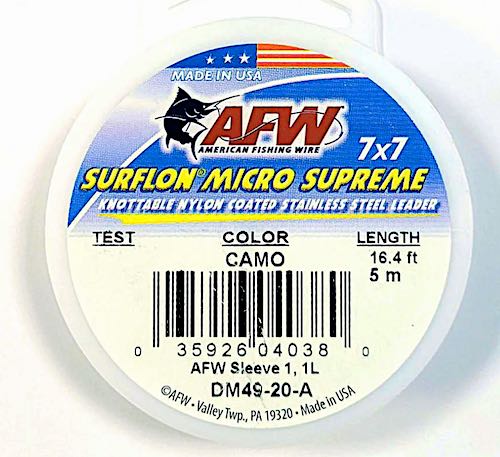
Other Gear for Pike Fly Fishing
Landing Net
Choose a large and strong landing net that is big enough to capture a large pike without causing it any damage. Ideally, opt for a net with a rubber mesh because hooks and a pike’s teeth are less likely to get tangled in the mesh. Also, they dry quickly and are less likely to develop a damp smell.
Unhooking Mat
Pike are a delicate species, and they need to be handled with care. Therefore, try to avoid removing the pike from the water but if you need to remove it a wet unhooking mat will help protect the fish while it is being unhooked. The wet mat protects the fish scales and the protective slime rather than resting the fish on the hard ground.
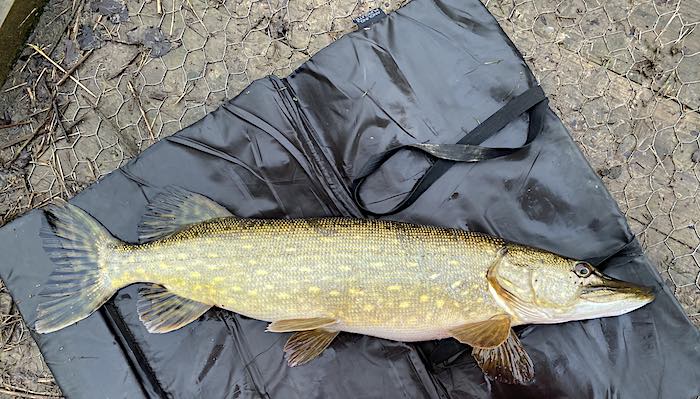
Mats come in a range of sizes; many roll or fold up and are easy to carry. It does not have to be expensive; a low-cost option is better than none.
Other Key Essentials include:
- Long-none forceps or nose pliers to remove hooks
- Scales and a weight bag
- Stripping guards help protect your fingers from burns when stripping lines all day.
Pike Fly Selection
As with other types of fly fishing the most frequently asked question is…
What pike flies do I need?
Fortunately, to start your pike fly fishing journey you won’t need boxes full of pike flies. Pike are opportunistic feeders, and their diet consists mainly of smaller fish, but also on the menu will be frogs, and even small birds or rodents.
Select files in various sizes and colours to accommodate varied water conditions and prey species. Sizes 1/0 to 5/0 are commonly used for pike, and colours such as black, white, chartreuse, and combinations of these colours can be particularly successful.
A good starting point is to investigate what’s likely to be on the pike’s menu in the stillwater or river you are going to fish. If the water you’ve chosen to fish contains course fish like roach and perch, then fly patterns in a range of sizes that imitate those species will catch pike.
The internet is awash with perch and roach fly patterns but the flies that have worked during my pike journey are:
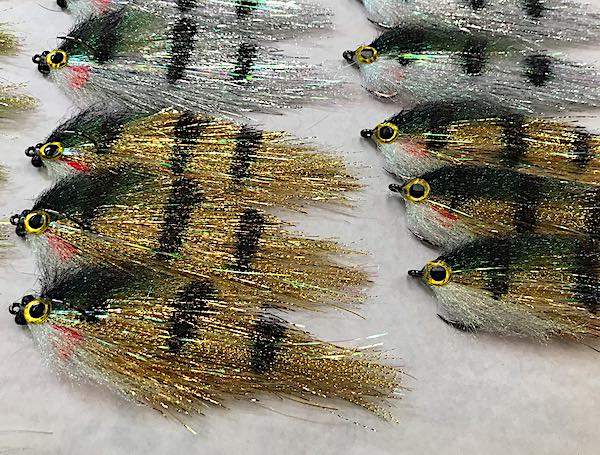
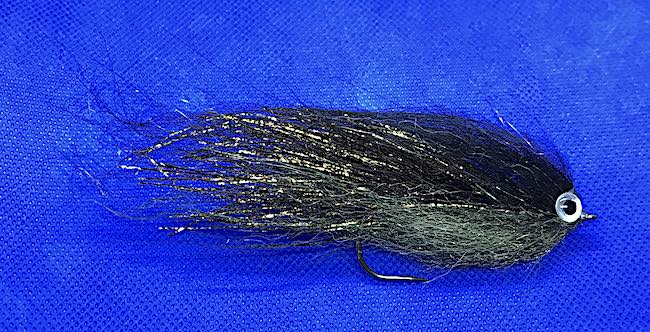
Whichever, pattern I’m using I found picking a size that matches the size of the fish that pike are likely to be feeding is often a recipe for success. For example, when pike are roaming the shallows for small bait fish, fishing small (3 to 4-inch) fly patterns often leads to success, whereas larger patterns are often ignored.
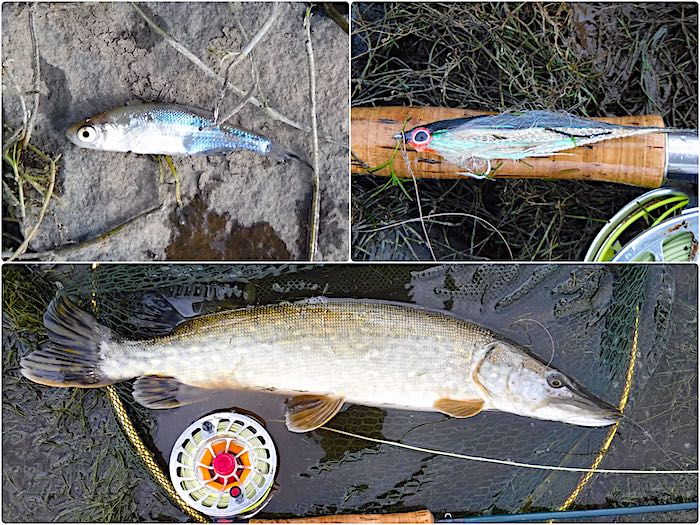
Customising pike flies with rattles or dragon or wiggle tails, can sometimes be the trigger stimulus required to entice a pike.
Surface patterns such as deer hair divers and poppers swim great and make a lot of surface disturbance and noise. They can be very effective on the day and you can also fish them on a sinking line over weed beds which allows you to fish them static or very slow, kind of like booby fishing for trout.
Now that we’ve got the tackle requirements covered it’s time to move on to…..
Pike Fly Fishing Tips for Beginners
1. Casting Pike Flies
Pike flies are typically big compared to the flies used for trout and salmon fishing and it takes practice to cast these large flies. However, the fundamentals of the fly cast are effectively the same.
My recommendation would be to have casting lessons with a qualified instructor if you’re new to fly fishing because it will put you on the right track and accelerate your learning. Also, experienced trout or salmon fly anglers will benefit from taking some pike fly casting lessons.
If you decide not to take lessons, it is essential before you go fishing to practise casting in a nearby field until you can smoothly cast large pike flies a reasonable distance (ca. 30m). For this practice I use a pike fly (1/0 to 3/0) where the hook had been cut back to the bend because it stops it hooking the ground.
Large, heavy flies are not aerodynamic and slow down the line turnover when casting. Don’t try to be too fast with your cast and allow everything to fully turnover before starting your next stroke, which allows the rod to fully load and then transfer the energy into the line.
It is better to be slower and smoother with a pike fly set-up because it will improve the quality and distance of your cast. Become familiar with the loading of the rod and get an idea of how far you can get good turnover. There’s no point stripping lots of line off the reel if the line doesn’t turnover and land straight.
2. Where to go Pike fly fishing?
When starting your pike fly fishing journey I would select a venue that holds a good head of pike, rather than one that is famed for big pike, because they should be easy to locate. Therefore, you can focus on developing your fishing technique (casting, retrieving and fly selection) while catching pike.
Also, it’s wise to go fishing with an experienced pike fly angler, whether that be a friend or a guide because they will show you how to handle and unhook the fish correctly and this will accelerate your learning.
If you’re not fishing with a guide, then I would start by fishing from the bank rather than a boat until you become proficient at casting pike flies, landing and unhooking your catch. Then you don’t have to worry about learning how to control the boat.
Pike are ambush predators, they often like to lie still and wait for prey fish to come into range before attacking. Therefore, focus efforts on fishing near weed beds, snags, jetties, moored boats, deep holes, underwater features and drop-offs. Because these are potential hiding places where pike will be able to ambush their prey.
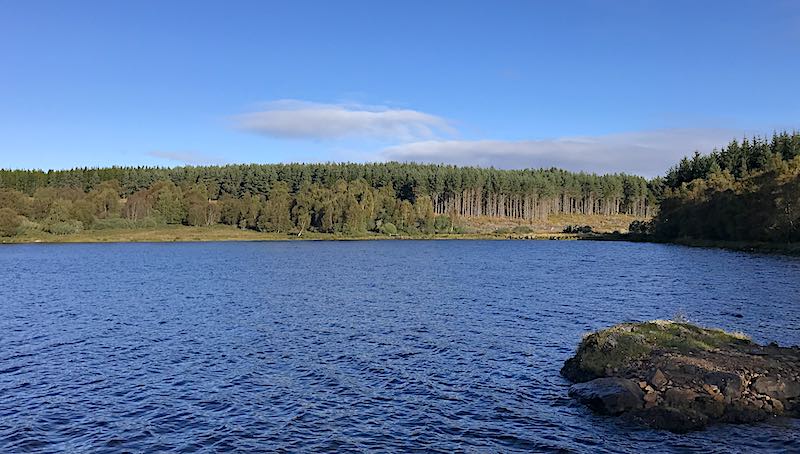
3. When to go fly fishing for pike?
When it comes to fly fishing for pike, timing is key because pike don’t feed like trout, carp or any number of other species. While other fish browse and eat lots of small food items, pike might just take one or two larger fish and stop feeding. Therefore, knowing the best time to target these fierce predators are active increases your chances of success.
While pike can be caught throughout the year, certain periods offer optimal conditions for pursuing these formidable fighters. Hence..It’s
it’s vital to be on the water when they want to feed.
Note, there might be season restrictions on your local venue and it’s generally accepted that they’re better left alone when they are spawning in the Spring.
In spring, as the water temperatures begin to rise, pike become active and start feeding aggressively. This is an excellent time to target them, as they search for food after the long winter months. During mild conditions…
The 1st hour of light is often Bite O’Clock
Fish the shallow areas with weedy cover and drop-offs, as pike often patrol these areas in search of baitfish.
Summer can be a challenging time for pike fly fishing, as they tend to move to deeper waters to escape the warm temperatures. However, early morning and late evening can still provide exciting opportunities. I don’t go pike fishing in the height of summer because high water temperatures put excessive stress on their recovery.
When autumn arrives, pike can go into a feeding frenzy to bulk up for the winter. This is arguably the best time for fly fishing for pike. Look for areas with fallen trees, weed beds, or drop-offs near deeper water – these are prime hunting grounds for hungry pike.
In winter, when water temperatures drop, pike are less active. However, if you can find areas with warmer water, such as inlets or areas with springs, you may still encounter pike. After cold nights late afternoon is often the most productive time. Slow retrieves and using larger flies to imitate injured prey can entice a strike even in the colder months.
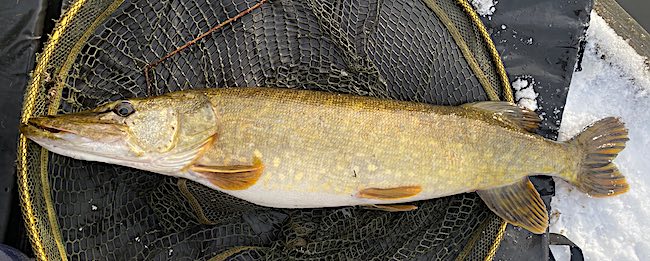
Remember, pike are opportunistic predators that ambush their prey. Using large, flashy streamers and poppers can trigger their aggression and provoke strikes. Patience, persistence, and adapting to the conditions will be key to your success.
A great shout here is to keep a diary and record the times when you get your bites. Fish are creatures of habit. Do your angling habits reflect this?
So, grab your fly rod and hit the water during these prime seasons for pike fly fishing. Prepare for an exhilarating experience battling these powerful predators. Good luck, and remember to practice catch and release, ensuring the future of this amazing species for generations to come.
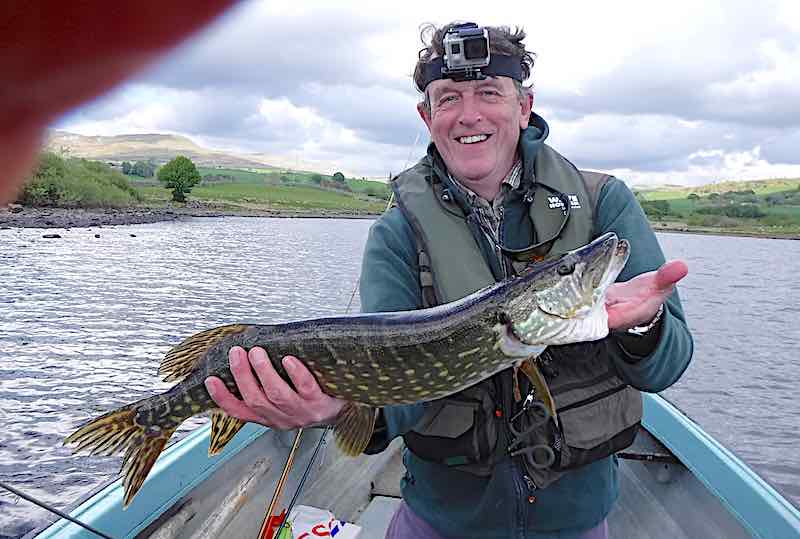
Great article Andrew but I don’t think pike fishing is for me – I don’t have the time to add another type of angling to my diary what with running my county fly fishing section Chair of my National river fly fishing group, teaching, competitions and pleasure fly fishing plus involvement with Fishing for Heroes, First Responding with the Ambulance Service and C0-Ordinating my county Voluntary Water Bailiff Service. Nevertheless It was a very interesting article and I do know a couple of lads that are keen on catching pike on the fly. Tight Lines. Iain.
Hi Iain,
Thanks for the feedback.
Tight lines, Andrew
Helpful article. Something I have been thinking of trying for a while on our local river where there are some very nice pike holding areas. Thanks Peter
Hi Peter,
Great to hear you’ve found it helpful.
Tight lines, Andrew
Thanks for such an informative article Andrew. I’ve been thinking about fly fishing for pike (and perch) for some time and I’ve found this blog a great introduction and inspiration. I bought a rod, reel, line, tippet, flies and so on a few years ago but just not got out on the water – despite living quite close to the Bridgewater Canal, which holds a decent head of both pike and perch.
Martin
Hi Martin,
Great to hear you found the article interesting and I hope it inspires you to give it a go. If you do it would be good to know how you get on fishing the Bridgewater canal.
Tight lines, Andrew
I remember my first experience trying to catch pike; it was thrilling! The tips on tackle and casting techniques resonate with me. I wish I’d had this guide back then; it would have made my learning curve much smoother. Understanding the importance of specific gear, like a strong rod and the right flies, is crucial. It’s all about patience and practicing those casts, especially with larger flies. I’m excited to apply these tips on my next fishing trip!
Hi Ryan,
Great to hear you enjoyed the post and thanks for the useful comments.
Tight lines, Andrew